The newest technology in Chesapeake Bay water quality monitoring is here, and high school students are partly responsible for creating it—at a fraction of the cost of typical water quality monitors.
Southern Maryland students and their teacher have been building and deploying automated buoys called Bay Observation Boxes (BOBs). It’s a partnership between the St. Mary’s River Watershed Association (SMRWA) and engineering students of Dorothy Birch at the Dr. James A. Forrest Career and Technology Center in St. Mary’s County.
Birch, a Natural Resources Management teacher, worked with her students to build 15 of the buoys over the past two years. The project responds to a need for widespread, inexpensive water quality monitoring that is more efficient than the old fashioned method of scooping samples by hand. The watershed association points out that most water quality monitoring happens in the Bay’s main stem, but conditions in tributaries are just as important for water cleanup efforts.
“When SMRWA is looking for new oyster sites, water quality data are imperative to our success in establishing reefs,” explains Executive Director Emma Green.
The engineering teachers and students assembled the kits for the buoys using microprocessor technology. They measure air and water temperature, humidity, dissolved oxygen, pH, electrical conductivity, total dissolved solids, and salinity. Every 15 minutes, live data is sent to thingspeak.com.
Each one costs about $900 to build. That’s a far cry from commercial equipment that sells for more than $20,000 in some cases.
“This project could change how we care for the Chesapeake Bay,” said Birch. “Affordable buoys could provide data about the hyperlocal ecosystems people care about and prompt them to protect their nearby creeks, streams, and coves as part of the larger watershed.”
Like most engineering projects, the BOBs need some further development and fine tuning. During the first year they were built, the partners established that the equipment can survive and function in the water almost indefinitely as long as it has power.
The watershed association is studying the data’s reliability by testing measurements side by side with the Chesapeake Biological Laboratory’s Patuxent Sentinel equipment. So far the sensors seem a little imprecise, but promising, SMRWA says. The group is exploring the ability to compensate for inexpensive instruments by adjusting their software programming.
As long as SMRWA continues to analyze side-by-side data, volunteers will continue collecting water samples by hand. They’re optimistic that the BOBs will eventually replace that process. Volunteer Norm O’Foran said, “We hope to be able to retire our kayaks.”
The partners plan to construct three more buoys. And other river organizations are exploring their use, too. The Friends of St. Clements Bay is using the BOB prototype, as its low cost holds appeal to small nonprofit groups who rely in testing water quality by hand.
In addition to its benefits for water monitoring, the project is a great opportunity for the engineering students to learn and be inspired to save the Bay. Students work hands on to wire circuits, calibrate equipment, clean and maintain the BOBs, and even brand the kits and design a website for them.
The students say creating BOBs taught them to work together and to look beyond the easy answers. “Not many people have done projects like this, so it’s not like you can just look it up on the Internet,” says student Josie Clarke.
The BOBs project has been funded by grants from the Chesapeake Bay Trust and two Chesapeake Oyster Alliance Innovation Awards.



